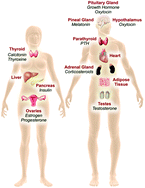*
Corresponding authors
a
Division of Extramural Research and Training, Cellular, Organ and Systems Pathobiology Branch, National Institute of Environmental Health Sciences, Research Triangle Park, NC, USA
E-mail:
schugt2@niehs.nih.gov, kpobrien@advancinggreenchemistry.org, jpmyers@ehsciences.org
b
Skaggs School of Pharmacy and Pharmaceutical Sciences, University of California, San Diego, La Jolla, CA, USA
c
Department of Developmental and Cell Biology, University of California, Irvine, Irvine, CA, USA
d
Department of Chemistry, Carnegie Mellon University, 4400 Fifth Avenue, Pittsburgh, PA, USA
e
Section of Integrative Biology, University of Texas at Austin, Austin, TX, USA
f
Center for Environmental Studies, Virginia Commonwealth University, Richmond, VA, USA
g
Advancing Green Chemistry , Charlottesville, VA, USA
h
School of Biological Sciences, Louisiana Tech University, Ruston, LA, USA
i
Institute for Neuroscience, University of Texas at Austin, Austin, TX, USA
j
Department of Obstetrics and Gynaecology, Medical University of South Carolina, Charleston, SC, USA
k
Laboratory for Integrative Studies in Amphibian Biology, Molecular Toxicology, Group in Endocrinology, Energy and Resources Group, Museum of Vertebrate Zoology, and Department of Integrative Biology, University of California, Berkeley, CA, USA
l
Centre for Green Chemistry and Catalysis, Department of Chemistry, McGill University, Montréal, QC, Canada
m
Department of Biology, North Carolina State University, Raleigh, NC, USA
n
Department of Environmental and Molecular Toxicology, Oregon State University, Corvallis, OR. Current Address: Integrated Systems Toxicology Division, National Health and Environmental Effects Research Laboratory, U.S. Environmental Protection Agency, Research Triangle Park, NC, USA
o
Office of Health Assessment and Translation, National Institute of Environmental Health Sciences, Research Triangle Park, NC, USA
p
Center for Regenerative and Developmental Biology and Department of Biology, Tufts University, Medford, MA, USA
q
Warner Babcock Institute for Green Chemistry, Wilmington, MA, USA
r
Center for Addiction Research, University of Texas Medical Branch, Galveston, TX, USA
s
Division of Biological Sciences and Department ,University of Missouri-Columbia, Columbia, MO, USA
t
Biology Department, University of Massachusetts-Amherst, Amherst, MA, USA
u
Environmental Health Sciences, Charlottesville, VA, USA


 Please wait while we load your content...
Please wait while we load your content...